Discover the 20 lowest/weakest currencies in the world as of 2023, based on their exchange rates against the US dollar. Explore which countries have the lowest-valued currencies, and learn more about the factors that can affect currency values.
Currency values can vary significantly based on a range of factors, including economic stability, political factors, global trade, and more. As of 2023, the following currencies are among the lowest/weakest in the world, based on their exchange rates against the US dollar.
What is currency?
Currency is a medium of exchange used to facilitate transactions between people or entities. It can be in the form of banknotes, coins, or digital currency. Currencies are typically issued and regulated by national governments or central banks, and they play a crucial role in facilitating trade and commerce within and between countries.
Currencies are often traded on foreign exchange markets, where their values fluctuate based on various economic and political factors, such as interest rates, inflation, and geopolitical events. The most common currencies include the US dollar, the euro, the Japanese yen, and the British pound.
Why Currency is an important for any country?
Currency is important for any country for several reasons:
Facilitating Trade and Commerce: A country’s currency is the medium of exchange that is used to purchase goods and services. The availability of a stable and widely accepted currency can facilitate both domestic and international trade and commerce.
Economic Growth: A stable and reliable currency can also help to support economic growth by providing a stable platform for businesses to plan and invest for the future. A stable currency can also help to reduce inflation and promote price stability, which can help to support economic growth.
National Identity: A country’s currency is often viewed as a symbol of national identity and pride. A distinctive currency with unique designs and images can help to promote the country’s cultural and historical heritage.
Control over Monetary Policy: The government or central bank of a country has significant control over the value of its currency, which can be used to regulate the country’s economy. For example, the central bank may choose to raise or lower interest rates to influence the exchange rate of the currency or control inflation.
International Relations: Currencies play a critical role in international trade and diplomatic relations. A country’s currency may be used as a tool for diplomacy or as a way to exert economic influence over other countries.
In summary, a country’s currency is essential for facilitating trade and commerce, promoting economic growth, national identity, control over monetary policy, and international relations.
Top 20 Most Lowest/Weakest currencies in the World 2023
Team Toplistin has mentioned below the 20 most weakest currency in the world which includes the Iranian Rial, Vietnamese Dong, Indonesian Rupiah, etc. Check out the complete list of the weakest currency in the world in 2023 mentioned below.
1. Iranian Rial (IRR)

As of February 2023, the Iranian Rial is the weakest currency in the world, with an exchange rate of approximately 37,800 IRR to one US dollar. The Rial has struggled due to a range of factors, including international sanctions, political instability, and inflation.
The Iranian Rial (IRR) is the official currency of Iran. It is abbreviated as “﷼” or “IRR” and is subdivided into 100 subunits called “dinars,” although dinars are no longer in circulation.
The current exchange rate of the Iranian Rial to the US Dollar is highly volatile due to various economic and political factors affecting Iran. As of my knowledge cutoff in September 2021, the exchange rate was around 42,000 IRR per US Dollar. However, it’s important to note that the exchange rate can fluctuate rapidly, sometimes changing by thousands of Rials in a single day.
In recent years, the Iranian economy has been impacted by a range of factors, including international sanctions, political instability, and a high rate of inflation. These issues have contributed to the devaluation of the Rial and made it difficult for many Iranians to maintain their standard of living.
It’s also worth noting that due to the difficulty of exchanging Iranian currency outside of Iran, travellers are generally advised to bring foreign currency, such as US Dollars or Euros, to exchange locally upon arrival.
2. Vietnamese Dong (VND)
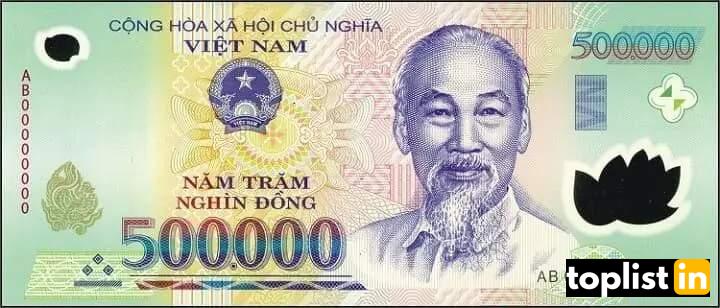
The Vietnamese Dong is the second weakest currency in the world, with an exchange rate of approximately 23,250 VND to one US dollar. The Dong has been impacted by factors such as a large trade deficit and a reliance on imported goods.
The Vietnamese Dong (VND) is the official currency of Vietnam, abbreviated as “₫” or “VND”. The Dong is divided into 10 hào or 100 xu, although the hào and xu are no longer in common circulation.
The exchange rate of the Vietnamese Dong to the US Dollar was approximately 23,000 VND per US Dollar. However, it’s important to note that the exchange rate can fluctuate depending on a variety of economic and political factors, as is the case with most currencies.
The Vietnamese economy has been growing in recent years, and the Dong has been relatively stable compared to many other emerging market currencies. The Vietnamese government has implemented a number of measures to maintain stability in the currency, including controlling inflation and maintaining healthy foreign reserves.
As a tourist destination, Vietnam is generally considered affordable for travellers. However, it’s important to note that while the Dong is a relatively weak currency, prices can still vary widely depending on the region and the type of establishment.
Major cities and tourist destinations tend to be more expensive, while rural areas and street markets can be very affordable. It’s a good idea to research local prices and budget accordingly before travelling to Vietnam.
3. Indonesian Rupiah (IDR)

The Indonesian Rupiah is the third weakest currency in the world, with an exchange rate of approximately 15,000 IDR to one US dollar. The Rupiah has struggled due to a range of factors, including high inflation and trade imbalances.
The Indonesian Rupiah (IDR) is the official currency of Indonesia, abbreviated as “Rp” or “IDR”. The Rupiah is subdivided into 100 sen, although sen coins are no longer in circulation due to inflation.
The exchange rate of the Indonesian Rupiah to the US Dollar was approximately 14,500 IDR per US Dollar. However, it’s important to note that the exchange rate can fluctuate depending on a variety of economic and political factors.
Indonesia has a large and rapidly growing economy, and the Rupiah is one of the most actively traded currencies in Southeast Asia.
Despite this, the Rupiah has been volatile in the past due to economic and political instability, as well as external factors such as changes in global commodity prices. The Indonesian government has taken steps to stabilize the currency in recent years, including maintaining a healthy level of foreign reserves and implementing various monetary policies.
As a tourist destination, Indonesia is generally considered affordable, with prices varying widely depending on the region and the type of establishment. Major cities and tourist destinations tend to be more expensive, while rural areas and street markets can be very affordable. It’s a good idea to research local prices and budget accordingly before travelling to Indonesia.
4. Guinean Franc (GNF)
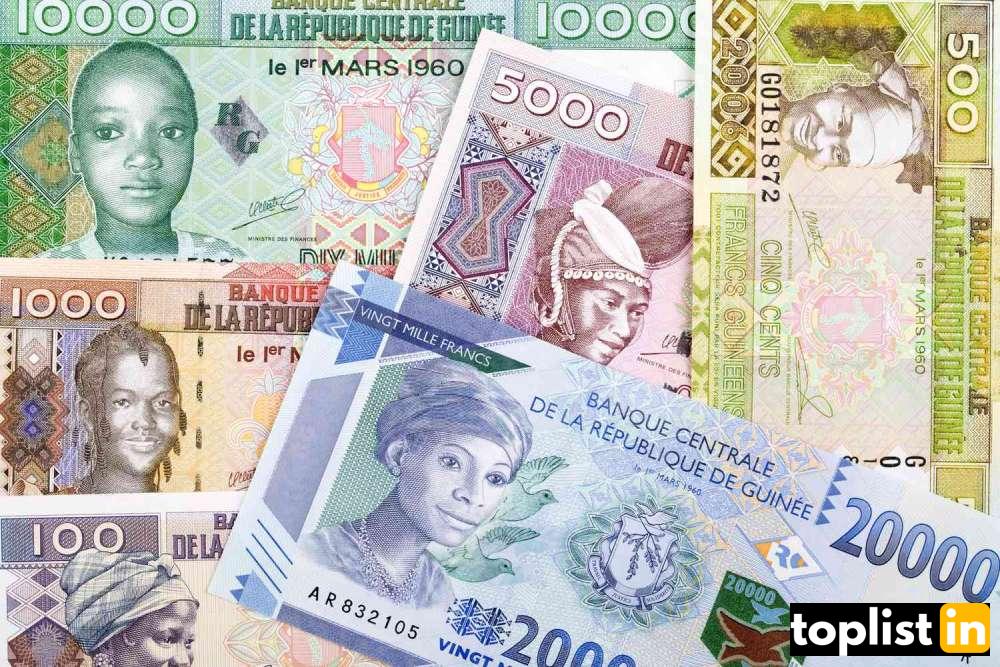
The Guinean Franc is the weakest currency in Africa, with an exchange rate of approximately 9,000 GNF to one US dollar. The Franc has been impacted by a range of factors, including high levels of poverty and economic instability.
The Guinean Franc (GNF) is the official currency of Guinea, abbreviated as “FG” or “GNF”. The Franc is subdivided into 100 centimes, although the centime is no longer in common use.
The exchange rate of the Guinean Franc to the US Dollar was approximately 9,500 GNF per US Dollar. However, it’s important to note that the exchange rate can fluctuate depending on a variety of economic and political factors.
Guinea is a developing country with an economy that is heavily dependent on natural resources, particularly minerals. The value of the Guinean Franc can be affected by changes in global commodity prices, as well as domestic economic and political developments.
As a tourist destination, Guinea is not commonly visited by international travelers, and tourism infrastructure is limited. However, the country is home to a number of natural and cultural attractions, including national parks, traditional villages, and historic sites.
Travelers should be aware that prices in Guinea are generally low, but that safety and security can be a concern in certain areas. It’s a good idea to research local conditions and safety information before traveling to Guinea.
5. Sierra Leonean Leone (SLL)

The Sierra Leonean Leone is the fifth weakest currency in the world, with an exchange rate of approximately 9,000 SLL to one US dollar. The Leone has struggled due to a range of factors, including political instability and an over-reliance on imports.
The Sierra Leonean Leone (SLL) is the official currency of Sierra Leone, abbreviated as “Le” or “SLL”. The Leone is subdivided into 100 cents, although the cent is not in common circulation.
The exchange rate of the Sierra Leonean Leone to the US Dollar was approximately 10,000 SLL per US Dollar. However, it’s important to note that the exchange rate can fluctuate depending on a variety of economic and political factors.
Sierra Leone is a developing country with an economy that is heavily dependent on natural resources, particularly minerals and agriculture. The value of the Leone can be affected by changes in global commodity prices, as well as domestic economic and political developments.
As a tourist destination, Sierra Leone is not commonly visited by international travelers, but it does have a growing tourism industry. The country is home to a number of natural and cultural attractions, including beaches, wildlife reserves, and historic sites.
Travelers should be aware that prices in Sierra Leone are generally low, but that safety and security can be a concern in certain areas. It’s a good idea to research local conditions and safety information before traveling to Sierra Leone.
6. Lao Kip (LAK)

The Lao Kip is the weakest currency in Southeast Asia, with an exchange rate of approximately 9,000 LAK to one US dollar. The Kip has been impacted by factors such as a trade deficit and an over-reliance on imported goods.
The Lao Kip (LAK) is the official currency of Laos, abbreviated as “₭” or “LAK”. The Kip is subdivided into 100 att, although the att is not in common use.
The exchange rate of the Lao Kip to the US Dollar was approximately 9,500 LAK per US Dollar. However, it’s important to note that the exchange rate can fluctuate depending on a variety of economic and political factors.
Laos is a developing country with a growing economy, and the value of the Kip can be affected by a variety of factors, including changes in global commodity prices, domestic economic and political developments, and exchange rate policies.
As a tourist destination, Laos is generally considered affordable, with prices varying widely depending on the region and the type of establishment. Major cities and tourist destinations tend to be more expensive, while rural areas and street markets can be very affordable.
Laos is home to a number of natural and cultural attractions, including historic temples, national parks, and scenic landscapes. It’s a good idea to research local prices and budget accordingly before traveling to Laos.
7. Uzbekistani Som (UZS)

The Uzbekistani Som is the seventh weakest currency in the world, with an exchange rate of approximately 10,600 UZS to one US dollar. The Som has struggled due to a range of factors, including inflation and a reliance on exports.
The Uzbekistani Som (UZS) is the official currency of Uzbekistan, abbreviated as “soʻm” or “UZS”. The Som is subdivided into 100 tiyin, although the tiyin is not commonly used due to its low value.
The exchange rate of the Uzbekistani Som to the US Dollar was approximately 10,000 UZS per US Dollar. However, it’s important to note that the exchange rate can fluctuate depending on a variety of economic and political factors.
Uzbekistan is a developing country with an economy that is heavily dependent on natural resources, particularly natural gas and cotton. The value of the Som can be affected by changes in global commodity prices, as well as domestic economic and political developments.
As a tourist destination, Uzbekistan is becoming increasingly popular, and tourism infrastructure is improving. The country is home to a number of cultural and historic attractions, including ancient cities, mosques, and madrasas. Travelers should be aware that prices in Uzbekistan are generally low, but that safety and security can be a concern in certain areas.
It’s a good idea to research local conditions and safety information before traveling to Uzbekistan.
8. Paraguayan Guarani (PYG)
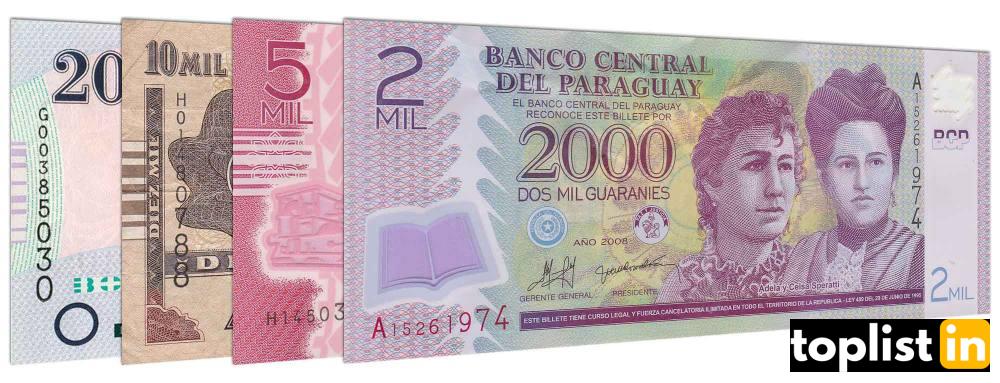
The Paraguayan Guarani is the weakest currency in South America, with an exchange rate of approximately 6,800 PYG to one US dollar. The Guarani has been impacted by factors such as a trade deficit and a reliance on agriculture.
The Paraguayan Guarani (PYG) is the official currency of Paraguay, abbreviated as “Gs” or “PYG”. The Guarani is subdivided into 100 centimos, although the centimo is not commonly used due to its low value.
The exchange rate of the Paraguayan Guarani to the US Dollar was approximately 6,700 PYG per US Dollar. However, it’s important to note that the exchange rate can fluctuate depending on a variety of economic and political factors.
Paraguay is a developing country with an economy that is heavily dependent on agriculture, particularly soybeans and beef. The value of the Guarani can be affected by changes in global commodity prices, as well as domestic economic and political developments.
As a tourist destination, Paraguay is not as commonly visited as some of its neighbors in South America, but it does have a growing tourism industry. The country is home to a number of natural and cultural attractions, including national parks, historic sites, and traditional markets.
Travelers should be aware that prices in Paraguay are generally low, but that safety and security can be a concern in certain areas. It’s a good idea to research local conditions and safety information before traveling to Paraguay.
9. Zambian Kwacha (ZMW)

The Zambian Kwacha is the weakest currency in Southern Africa, with an exchange rate of approximately 18 ZMW to one US dollar. The Kwacha has struggled due to a range of factors, including inflation and political instability.
The Zambian Kwacha (ZMW) is the official currency of Zambia, abbreviated as “K” or “ZMW”. The Kwacha is subdivided into 100 ngwee, although the ngwee is not in common use.
The exchange rate of the Zambian Kwacha to the US Dollar was approximately 16 ZMW per US Dollar. However, it’s important to note that the exchange rate can fluctuate depending on a variety of economic and political factors.
Zambia is a developing country with an economy that is heavily dependent on copper mining and agriculture, particularly maize and tobacco. The value of the Kwacha can be affected by changes in global commodity prices, as well as domestic economic and political developments.
As a tourist destination, Zambia is known for its national parks, wildlife reserves, and natural wonders such as Victoria Falls. The country is generally considered to be affordable for travelers, with prices varying depending on the region and the type of establishment.
It’s a good idea to research local prices and budget accordingly before traveling to Zambia. Travelers should also be aware that safety and security can be a concern in certain areas, and it’s important to research local conditions and safety information before traveling to Zambia.
10. Tanzanian Shilling (TZS)
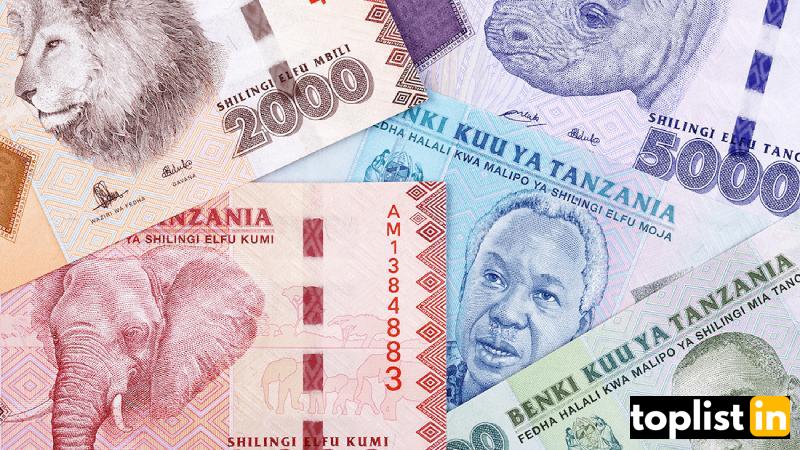
The Tanzanian Shilling is the tenth weakest currency in the world, with an exchange rate of approximately 2,300 TZS to one US dollar. The Shilling has been impacted by factors such as a trade deficit and an over-reliance on imported goods.
The Tanzanian Shilling (TZS) is the official currency of Tanzania, abbreviated as “TSh” or “TZS”. The Shilling is subdivided into 100 cents, although the cent is not in common use.
The exchange rate of the Tanzanian Shilling to the US Dollar was approximately 2,300 TZS per US Dollar. However, it’s important to note that the exchange rate can fluctuate depending on a variety of economic and political factors.
Tanzania is a developing country with an economy that is heavily dependent on agriculture, particularly coffee, tea, and cashew nuts, as well as tourism. The value of the Shilling can be affected by changes in global commodity prices, as well as domestic economic and political developments.
As a tourist destination, Tanzania is known for its natural attractions, including national parks, wildlife reserves, and beaches. The country is generally considered to be affordable for travelers, with prices varying depending on the region and the type of establishment.
It’s a good idea to research local prices and budget accordingly before traveling to Tanzania. Travelers should also be aware that safety and security can be a concern in certain areas, and it’s important to research local conditions and safety information before traveling to Tanzania.
11. Mozambican Metical (MZN)

The Mozambican Metical is the eleventh weakest currency in the world, with an exchange rate of approximately 79 MZN to one US dollar. The Metical has struggled due to factors such as high levels of debt and inflation.
The Mozambican Metical (MZN) is the official currency of Mozambique, abbreviated as “MT” or “MZN”. The Metical is subdivided into 100 centavos, although the centavo is not commonly used due to its low value.
The exchange rate of the Mozambican Metical to the US Dollar was approximately 62 MZN per US Dollar. However, it’s important to note that the exchange rate can fluctuate depending on a variety of economic and political factors.
Mozambique is a developing country with an economy that is heavily dependent on natural resources, particularly minerals, and agriculture, particularly cashew nuts and cotton. The value of the Metical can be affected by changes in global commodity prices, as well as domestic economic and political developments.
As a tourist destination, Mozambique is known for its beaches and marine wildlife. The country is generally considered to be affordable for travelers, with prices varying depending on the region and the type of establishment. It’s a good idea to research local prices and budget accordingly before traveling to Mozambique.
Travelers should also be aware that safety and security can be a concern in certain areas, and it’s important to research local conditions and safety information before traveling to Mozambique.
12. Central African CFA Franc (XAF)

The Central African CFA Franc is used by several countries in central Africa, and has an exchange rate of approximately 560 XAF to one US dollar. The Franc has been impacted by a range of factors, including political instability, poor economic management, and reliance on exports.
The Central African CFA Franc (XAF) is the official currency of six countries in Central Africa: Cameroon, Central African Republic, Chad, Republic of the Congo, Equatorial Guinea, and Gabon. It is one of two CFA Franc currencies in circulation in Africa, the other being the West African CFA Franc (XOF).
The Central African CFA Franc is pegged to the Euro at a fixed exchange rate, with 1 Euro equivalent to 655.957 XAF. The Franc is subdivided into 100 centimes, although the centime is not in common use.
As of my knowledge cutoff in September 2021, the exchange rate of the Central African CFA Franc to the US Dollar was approximately 550 XAF per US Dollar. However, it’s important to note that the exchange rate is fixed to the Euro and does not fluctuate on the foreign exchange market.
The countries that use the Central African CFA Franc are primarily dependent on natural resources, particularly oil and minerals. The value of the Franc can be affected by changes in global commodity prices, as well as domestic economic and political developments.
As a tourist destination, the countries that use the Central African CFA Franc offer a range of attractions, including wildlife parks and natural wonders such as waterfalls and beaches. Prices for tourists can vary depending on the region and the type of establishment, but are generally considered to be affordable.
Travelers should also be aware that safety and security can be a concern in certain areas, and it’s important to research local conditions and safety information before traveling to these countries.
13. Burundian Franc (BIF)
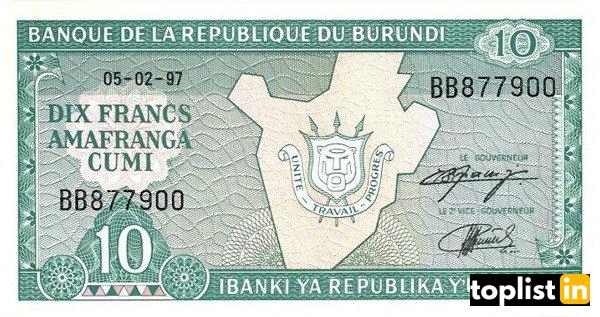
The Burundian Franc is the thirteenth weakest currency in the world, with an exchange rate of approximately 1,950 BIF to one US dollar. The Franc has struggled due to a range of factors, including political instability and poor economic management.
The Burundian Franc (BIF) is the official currency of Burundi, abbreviated as “FBu” or “BIF”. The Franc is subdivided into 100 centimes, although the centime is not commonly used due to its low value.
The exchange rate of the Burundian Franc to the US Dollar was approximately 1,900 BIF per US Dollar. However, it’s important to note that the exchange rate can fluctuate depending on a variety of economic and political factors.
Burundi is a developing country with an economy that is heavily dependent on agriculture, particularly coffee and tea. The value of the Franc can be affected by changes in global commodity prices, as well as domestic economic and political developments.
As a tourist destination, Burundi is less visited than some other countries in the region but does offer a range of attractions, including national parks, lakes, and cultural sites. Prices for tourists can vary depending on the region and the type of establishment but are generally considered to be affordable.
Travellers should also be aware that safety and security can be a concern in certain areas, and it’s important to research local conditions and safety information before traveling to Burundi.
14. Sao Tome and Principe Dobra (STD)
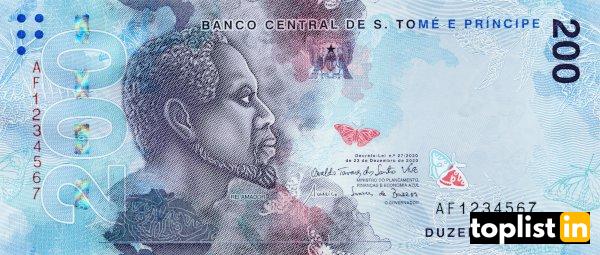
The Sao Tome and Principe Dobra is the weakest currency in Africa after the Guinean Franc, with an exchange rate of approximately 38,000 STD to one US dollar. The Dobra has been impacted by a range of factors, including high levels of debt and political instability.
The São Tomé and Príncipe Dobra (STD) is the official currency of São Tomé and Príncipe, abbreviated as “Db” or “STD”. The Dobra is subdivided into 100 cêntimos, although the cêntimo is not commonly used due to its low value.
The exchange rate of the São Tomé and Príncipe Dobra to the US Dollar was approximately 20,500 STD per US Dollar. However, it’s important to note that the exchange rate can fluctuate depending on a variety of economic and political factors.
São Tomé and Príncipe is a small island country located off the coast of Central Africa. The economy is heavily dependent on cocoa exports and aid from international donors. The value of the Dobra can be affected by changes in global commodity prices, as well as domestic economic and political developments.
As a tourist destination, São Tomé and Príncipe offers a range of attractions, including beaches, national parks, and cultural sites. Prices for tourists can vary depending on the region and the type of establishment, but are generally considered to be affordable.
Travelers should also be aware that safety and security can be a concern in certain areas, and it’s important to research local conditions and safety information before traveling to São Tomé and Príncipe.
15. Congolese Franc (CDF)

The Congolese Franc is used in both the Democratic Republic of Congo and the Republic of Congo, and has an exchange rate of approximately 1,750 CDF to one US dollar. The Franc has struggled due to factors such as political instability and a reliance on exports.
The Congolese Franc (CDF) is the official currency of the Democratic Republic of the Congo, abbreviated as “FC” or “CDF”. The Franc is subdivided into 100 centimes, although the centime is not commonly used due to its low value.
The exchange rate of the Congolese Franc to the US Dollar was approximately 1,900 CDF per US Dollar. However, it’s important to note that the exchange rate can fluctuate depending on a variety of economic and political factors.
The Democratic Republic of the Congo is a country in Central Africa with a wealth of natural resources, including minerals and timber. However, the country has faced significant political instability and conflict in recent years, which has had an impact on its economy and the value of the Franc.
As a tourist destination, the Democratic Republic of the Congo offers a range of attractions, including national parks with wildlife and natural wonders such as waterfalls and lakes. Prices for tourists can vary depending on the region and the type of establishment, but are generally considered to be affordable.
However, safety and security can be a major concern in certain areas, and it’s important to research local conditions and safety information before traveling to the Democratic Republic of the Congo.
16. Sudanese Pound (SDG)

The Sudanese Pound is the weakest currency in the Middle East, with an exchange rate of approximately 135 SDG to one US dollar. The Pound has been impacted by a range of factors, including political instability and economic sanctions.
The Sudanese Pound (SDG) is the official currency of Sudan, abbreviated as “SDG”. The Pound is subdivided into 100 piasters, although the piaster is not commonly used due to its low value.
The exchange rate of the Sudanese Pound to the US Dollar was approximately 380 SDG per US Dollar. However, it’s important to note that the exchange rate can fluctuate depending on a variety of economic and political factors.
Sudan is a country located in North Africa with a diverse economy, including agriculture, mining, and oil production. The value of the Pound can be affected by changes in global commodity prices, as well as domestic economic and political developments.
As a tourist destination, Sudan offers a range of attractions, including historical sites such as ancient pyramids and temples, as well as natural wonders such as the Nile River and desert landscapes.
Prices for tourists can vary depending on the region and the type of establishment, but are generally considered to be affordable. However, travelers should be aware that safety and security can be a concern in certain areas, and it’s important to research local conditions and safety information before traveling to Sudan.
17. Liberian Dollar (LRD)

The Liberian Dollar is the seventeenth weakest currency in the world, with an exchange rate of approximately 200 LRD to one US dollar. The Dollar has struggled due to factors such as high levels of corruption and economic instability.
The Liberian Dollar (LRD) is the official currency of Liberia, abbreviated as “LD” or “LRD”. The Dollar is subdivided into 100 cents, although the cent is not commonly used due to its low value.
The exchange rate of the Liberian Dollar to the US Dollar was approximately 171 LD per US Dollar. However, it’s important to note that the exchange rate can fluctuate depending on a variety of economic and political factors.
Liberia is a country located on the west coast of Africa with an economy that is heavily dependent on natural resources such as rubber, timber, and minerals. The value of the Dollar can be affected by changes in global commodity prices, as well as domestic economic and political developments.
As a tourist destination, Liberia offers a range of attractions, including beaches, wildlife reserves, and cultural sites.
Prices for tourists can vary depending on the region and the type of establishment, but are generally considered to be affordable. However, travelers should be aware that safety and security can be a concern in certain areas, and it’s important to research local conditions and safety information before traveling to Liberia.
18. Somali Shilling (SOS)

The Somali Shilling is the weakest currency in East Africa, with an exchange rate of approximately 580 SOS to one US dollar. The Shilling has been impacted by a range of factors, including political instability and high levels of poverty.
The Somali Shilling (SOS) is the official currency of Somalia, abbreviated as “S” or “SOS”. The Shilling is subdivided into 100 cents, although the cent is not commonly used due to its low value.
The exchange rate of the Somali Shilling to the US Dollar was approximately 575 SOS per US Dollar. However, it’s important to note that the exchange rate can fluctuate depending on a variety of economic and political factors.
Somalia is a country located on the Horn of Africa, with an economy that is heavily dependent on livestock, agriculture, and fishing. The country has experienced significant political instability and conflict in recent years, which has had a negative impact on its economy and the value of the Shilling.
As a tourist destination, Somalia is currently not considered safe for travel due to ongoing security concerns and conflict. While there are some attractions such as historical and cultural sites, it is not recommended to visit the country as a tourist at this time.
19. Yemeni Rial (YER)

The Yemeni Rial is the weakest currency in the Arabian Peninsula, with an exchange rate of approximately 620 YER to one US dollar. The Rial has been impacted by a range of factors, including political instability and conflict.
The Yemeni Rial (YER) is the official currency of Yemen, abbreviated as “YR” or “YER”. The Rial is subdivided into 100 fils, although the fils is not commonly used due to its low value.
The exchange rate of the Yemeni Rial to the US Dollar was approximately 250 YER per US Dollar. However, it’s important to note that the exchange rate can fluctuate depending on a variety of economic and political factors.
Yemen is a country located on the southern tip of the Arabian Peninsula with an economy that is heavily dependent on oil and natural gas production. The country has experienced significant political instability and conflict in recent years, which has had a negative impact on its economy and the value of the Rial.
As a tourist destination, Yemen is currently not considered safe for travel due to ongoing security concerns and conflict. The country has a rich history and culture, with historical sites such as the ancient city of Sana’a and natural wonders such as the Socotra archipelago. However, it is not recommended to visit the country as a tourist at this time.
20. Belarusian Ruble (BYN)
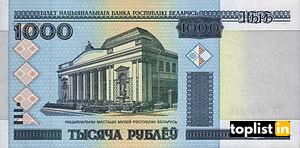
The Belarusian Ruble is the weakest currency in Europe, with an exchange rate of approximately 2 BYN to one US dollar. The Ruble has struggled due to a range of factors, including economic sanctions and political instability.
The Belarusian Ruble (BYN) is the official currency of Belarus, abbreviated as “Br” or “BYN”. The Ruble is subdivided into 100 kopeks, although the kopek is not commonly used due to its low value.
The exchange rate of the Belarusian Ruble to the US Dollar was approximately 2.55 BYN per US Dollar. However, it’s important to note that the exchange rate can fluctuate depending on a variety of economic and political factors.
Belarus is a landlocked country located in Eastern Europe, with an economy that is heavily dependent on manufacturing, especially in the areas of heavy machinery, electronics, and petrochemicals. The value of the Ruble can be affected by changes in global commodity prices, as well as domestic economic and political developments.
As a tourist destination, Belarus offers a range of attractions, including historical sites such as the medieval castle in Mir and the capital city of Minsk, which is known for its architecture and cultural events.
Prices for tourists can vary depending on the region and the type of establishment but are generally considered to be affordable compared to other European countries. However, travelers should be aware of visa requirements and may encounter some language barriers when traveling in the country.
Conclusion
Top Most 20 Weakest currencies in the World 2023
| Iranian Rial (IRR) |
| Vietnamese Dong (VND) |
| Indonesian Rupiah (IDR) |
| Guinean Franc (GNF) |
| Sierra Leonean Leone (SLL) |
| Lao Kip (LAK) |
| Uzbekistani Som (UZS) |
| Paraguayan Guarani (PYG) |
| Zambian Kwacha (ZMW) |
| Tanzanian Shilling (TZS) |
| Mozambican Metical (MZN) |
| Central African CFA Franc (XAF) |
| Burundian Franc (BIF) |
| Sao Tome and Principe Dobra (STD) |
| Congolese Franc (CDF) |
| Sudanese Pound (SDG) |
| Liberian Dollar (LRD) |
| Somali Shilling (SOS) |
| Yemeni Rial (YER) |
| Belarusian Ruble (BYN) |
In conclusion, the 20 currencies listed above are currently among the weakest in the world in 2023, based on their exchange rates compared to the US dollar. Many of these currencies have been impacted by a range of factors, including political instability, economic sanctions, corruption, and reliance on exports. However, it’s worth noting that currency values can be volatile and subject to change based on a range of factors, such as changes in global economics and politics.
While a weak currency can create challenges for a country, it’s important to remember that there are other factors that can contribute to a country’s economic success, such as strong institutions, a skilled workforce, and natural resources. Many countries have successfully overcome currency weaknesses and gone on to develop robust and prosperous economies.
Overall, the ranking of the weakest currencies in the world serves as a reminder of the importance of sound economic policies, stable institutions, and effective governance in promoting economic stability and growth. It is also a reminder of the potential consequences of political instability, economic sanctions, and other external factors that can impact a country’s economy and its currency.









